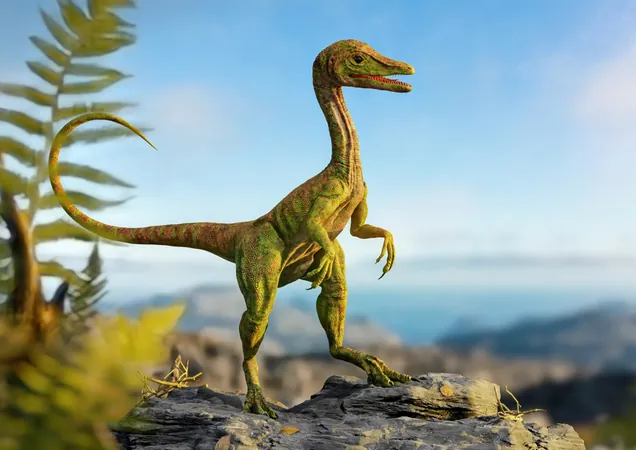
North America's Oldest Dinosaur: The Game-Changer in Prehistoric History!
2025-01-08
Author: Yan
Have you ever pondered the origins of the age of dinosaurs? For years, scientists have grappled with this question, relying heavily on fragmented fossil records and a host of evolving theories. Traditionally, it was believed that dinosaurs emerged in the southern regions of the ancient supercontinent Pangea, mainly on Gondwana, and only later migrated to the northern landmass of Laurasia, which includes modern-day North America.
However, a groundbreaking discovery in Wyoming is about to flip this theory on its head.
The Remarkable Discovery
In 2013, researchers from the University of Wisconsin-Madison stumbled upon fossilized remains in the Popo Agie Formation, a locale once situated near the equator in ancient Laurasia. After years of meticulous examination, the team has unveiled a new species of dinosaur: Ahvaytum bahndooiveche. This dinosaur, which lived approximately 230 million years ago, is now recognized as the oldest known dinosaur from Laurasia, challenging long-standing assumptions about the geographical origins of dinosaurs.
Dr. Dave Lovelace, a prominent scientist from the UW Geology Museum, stated, "With these fossils, we've identified the oldest equatorial dinosaur in the world—North America's oldest dinosaur.” This indicates that dinosaurs were indeed flourishing in what is now North America during a time when they were assumed to be primarily located in the Southern Hemisphere.
Understanding Laurasia and Its Significance
Laurasia was one of the colossal supercontinents that emerged during the late Paleozoic and early Mesozoic eras, comprising what today are North America, Europe, and parts of Asia. Approximately 200 million years ago, the land broke apart from Pangaea, leading to the formation of distinct continents.
As this landmass divided, it significantly influenced global geography, including the expansion of the Atlantic Ocean between North America and Europe. This separation also had profound effects on climate, helping to create environments conducive to diverse life forms, including the early dinosaurs that roamed Laurasia.
About Ahvaytum bahndooiveche
In stark contrast to the enormous dinosaurs that later dominated the landscape, Ahvaytum bahndooiveche was relatively small—about the size of a chicken, sporting a long tail. Dr. Lovelace has described it as “measuring just over one foot tall and three feet long,” suggesting an omnivorous diet similar to some early sauropods.
Although the fossil record remains incomplete, initial findings indicate that this species thrived during a critical transitional phase following the Carnian pluvial episode, which transformed arid deserts into fertile environments, aiding the proliferation of early dinosaurs.
Sparking a New Narrative in Dinosaur Evolution
Using advanced radioisotopic dating techniques, scientists have confirmed that Ahvaytum bahndooiveche existed around 230 million years ago—placing it among the oldest known dinosaurs of the Northern Hemisphere. Notably, previous tracks found in the same region hint that dinosaur-like creatures may have roamed there even earlier, challenging the long-spoken theory that dinosaurs originated only in the Southern Hemisphere.
This discovery also marks a significant collaboration with the Eastern Shoshone Tribe, contributing to a broader understanding of the cultural context surrounding the fossils. The dinosaur's name, meaning "long ago dinosaur," pays homage to the Indigenous communities whose ancestral lands were home to the site.
A Legacy of Collaboration and Ethical Research
Amanda LeClair-Diaz, an Eastern Shoshone tribal member, emphasized the importance of this collaborative effort: “The ongoing relationship developed between Dr. Lovelace's team and our community redefines how research is conducted, fostering a reciprocal model that respects Indigenous knowledge.”
Beyond providing valuable new insights into the origins of dinosaurs, the finding of Ahvaytum bahndooiveche illustrates the importance of integrating diverse perspectives in scientific inquiry. By partnering with Indigenous communities, this research initiative sets a new benchmark for inclusivity and ethical practices in paleontology.
This modest dinosaur not only redefines our understanding of the prehistoric narrative but also advocates for a progressive approach to scientific endeavors—one that honors both the world's ancient past and its rich cultural tapestry.
Discover More
Stay tuned for more updates about the fascinating discoveries in the world of paleontology that continue to reshape our understanding of history! Don’t miss our upcoming articles as we unveil more astonishing secrets of the prehistoric world!

 Brasil (PT)
Brasil (PT)
 Canada (EN)
Canada (EN)
 Chile (ES)
Chile (ES)
 Česko (CS)
Česko (CS)
 대한민국 (KO)
대한민국 (KO)
 España (ES)
España (ES)
 France (FR)
France (FR)
 Hong Kong (EN)
Hong Kong (EN)
 Italia (IT)
Italia (IT)
 日本 (JA)
日本 (JA)
 Magyarország (HU)
Magyarország (HU)
 Norge (NO)
Norge (NO)
 Polska (PL)
Polska (PL)
 Schweiz (DE)
Schweiz (DE)
 Singapore (EN)
Singapore (EN)
 Sverige (SV)
Sverige (SV)
 Suomi (FI)
Suomi (FI)
 Türkiye (TR)
Türkiye (TR)
 الإمارات العربية المتحدة (AR)
الإمارات العربية المتحدة (AR)